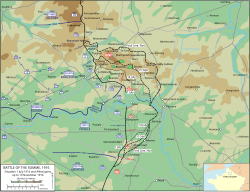| Capture of Le Sars | |||||||
|---|---|---|---|---|---|---|---|
| Part of The Battle of the Somme, First World War | |||||||
 Battle of the Somme 1 July – 18 November 1916 | |||||||
| |||||||
| Belligerents | |||||||
|
|
| ||||||
| Commanders and leaders | |||||||
| Douglas Haig | Erich Ludendorff | ||||||
| Strength | |||||||
| 23rd Division | 4th Ersatz Division | ||||||
| Casualties and losses | |||||||
| 737 | 528 taken prisoner | ||||||
The Capture of Le Sars was a tactical incident during the Battle of the Somme. Le Sars is a commune in the Pas-de-Calais department in the Nord-Pas-de-Calais region of France. The village lies along the Albert–Bapaume road. The village is situated 16 mi (26 km) south of Arras, at the junction of the D 11 and the D 929 roads. Courcelette lies to the south, Pys and Miraumont to the north-west, Eaucourt l'Abbaye to the south-east, the Butte de Warlencourt is to the north-east and Destremont Farm is south-west.
Military operations began in the area in September 1914 during the Race to the Sea, when the divisions of the II Bavarian Corps advanced westwards on the north bank of the Somme, passing through Le Sars towards Albert and Amiens. The village became a backwater until 1916, when the British and French began the Battle of the Somme (1 July – 13 November) and was the site of several air operations by the Royal Flying Corps, which attacked German supply dumps in the vicinity. During the Battle of Flers–Courcelette (15–22 September), the British Fourth Army advanced close to the village and operations to capture it began on 1 October. The village was overrun by the 23rd Division on 7 October, during the Battle of Le Transloy (1 October – 5 November), several hundred prisoners being taken from the [[4th Ersatz Division (German Empire)|4th Ersatz Division]].
After the village was captured, the crest of the rise to the east became the limit of the British advance. In the winter of 1916–1917, which was the worst for fifty years, the area was considered by the troops of the I Anzac Corps to be the foulest sector of the Somme front. The village was lost in March 1918 and recaptured for the last time in August by the 21st Division.
